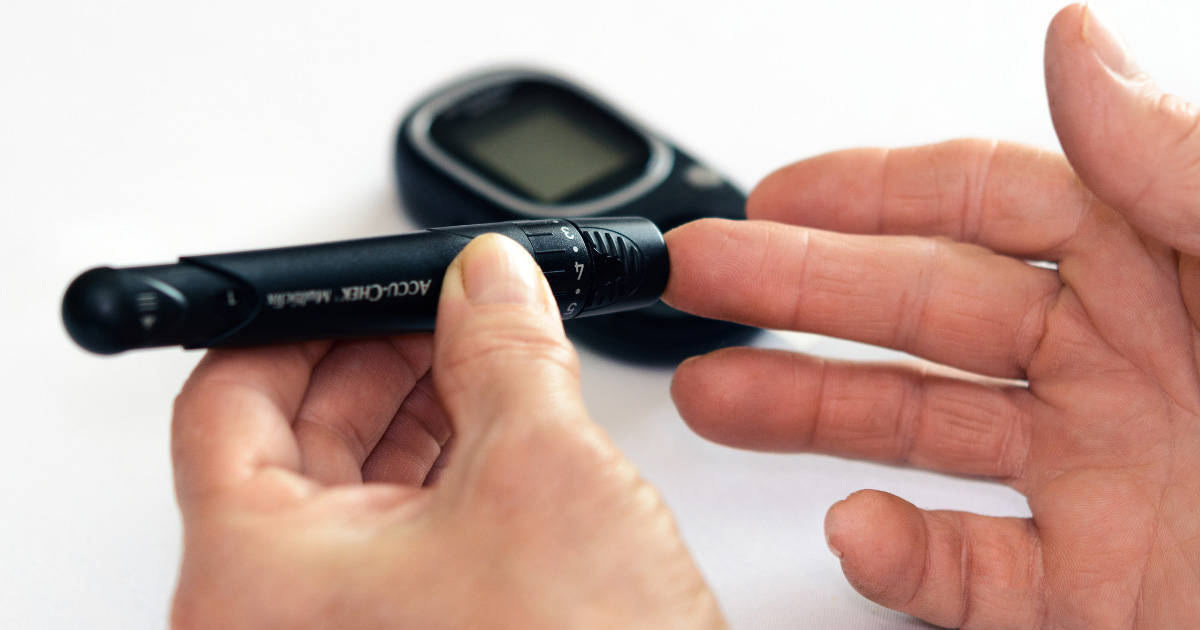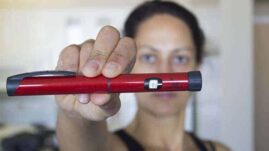People with diabetes are encouraged to check their blood sugars often, and with the latest technology like continuous glucose monitors (CGMs), the frequency of checking has increased more than ever.
But what if you’re using a glucometer, lancet device, and test strips? How often, and maybe more importantly, exactly when should you check your blood sugar?
This article will outline the importance of checking your blood sugar, how often, and when you really should check for better diabetes management.

Why is blood sugar checking important?
If you live with diabetes, a blood sugar check is paramount to good control. Without knowing your blood glucose numbers, you cannot appropriately dose insulin, treat a low blood sugar, eat a meal, or exercise with ease.
Think of a blood sugar check as a litmus test: the number isn’t good or bad, it just gives a person with diabetes feedback on what they need to do next.
If a number is too high (and always consult with your doctor about a target range that fits you and your lifestyle best), it’s telling you to take some insulin or get some exercise, whereas if a number is too low, you’ll need to treat with sugar or some other form of glucose.
If your number is satisfactory, then you can proceed on with your day as planned.
Checking your blood sugar is also important to track long-term goals, like an hba1c test, and to see if you’re reaching or even exceeding those goals.
Regularly checking your blood sugar also can give you feedback on what’s working and what’s not: maybe a particular food isn’t working for your management goals, or a type of exercise, like yoga, has really helped to mellow out your blood sugar levels.
It’s a good time to check in with yourself and calibrate your management to find what will work best for you, knowing that this can and will change over time.
How often should you check your blood sugar?
As with most things dealing with diabetes, this all depends on your particular body and lifestyle. Work with your care team and doctor to determine the appropriate number of times per day that you should be checking your blood sugars.
Know that not only is everyone different, but people’s needs for more or less frequent checking can change over their lifetime.
For instance, when someone is pregnant, their need for checking goes up immensely, and conversely, if someone with type 2 diabetes weans their way off of insulin, they may need to check less frequently as their likelihood of hypoglycemia is lower without exogenous insulin in their system.
According to the Mayo Clinic, people with type 1 diabetes should at a minimum check between 4 and 10 times per day, and people with type 2 diabetes may only need to check a few times a day (if on insulin), and maybe not at all if they are not on insulin.
But let’s be clear: you can check as many times as you need to, and however often you’d like (barring expensive test strips or limitations set by your health insurance company). There is nothing wrong with checking more often or whenever you like.
When should you check your blood sugar?
While everyone’s diabetes experience may vary, there are some good guidelines that most people should follow:
Upon waking
The best way for a person with diabetes to start their day is by checking their blood sugar. This can help you course-correct any highs or lows before any food is eaten, exercise is done, or work is started, and can help to get you on the right track for the day.
Starting a new day without knowing your blood sugar is similar to driving with a blindfold on!
Keeping a meter, test strips, lancet device, and an alcohol swab at your bedside can act as a good reminder to check your blood sugar the moment you wake up.
Before and after meals and snacks
If you eat first thing in the morning, your first blood sugar check of the day can also count as your pre-meal check, but if you don’t, you’ll need to check again before breakfast.
This can inform you as to how much insulin you’ll need for your meal (if you’re insulin-dependent). If you’re running a little high, you’ll need to bolus extra, but if your blood sugar is on the lower end, you can take a little less insulin for any carbohydrates eaten.
Checking before every meal and snack can help curb postprandial glucose excursions, otherwise known as the stubborn high blood sugars you sometimes can experience after eating a meal and not adequately bolusing for said meal.
Ideally, you should also be checking 2 hours after all meals as well, to determine if your meal bolus was adequate, if you took too much insulin, or if you need to adjust and take more insulin.
Two hours is the recommended time frame, because by then most carbohydrates have been absorbed into the body and most fast-acting insulin has already peaked.
When checking before snacks (between meals), make sure you’re calculating any active insulin on board so you don’t overtreat a high and end up going low.
Before and after exercise
This is crucial, because exercising with a low or even in-range blood sugar level can be dangerous, depending on the length and intensity of the exercise you plan to do.
Make sure to work with your doctor to determine an appropriate pre-exercise blood sugar level, but people usually like to have their levels sit a little higher than normal before starting any vigorous cardiovascular exercise to prevent severe hypoglycemia.
On the other hand, some people’s blood sugars tend to rise during exercise, especially if they are doing weightlifting or types of exercise that spike adrenaline levels in the body. It’s important to make sure your blood sugar is at an appropriate level in case it will rise during your workout.
You also don’t want your blood sugar to be too high before exercise, either. The Mayo Clinic actually advises against people with diabetes exercising if their starting blood sugar is above 250 mg/dL.
This is due to the fact that if a body is exercising without enough insulin in the bloodstream, the liver and kidneys will inadvertently release more sugar into the body, increasing your number even more and putting you at risk for dehydration, ketones, and even increased risk of spiraling into diabetic ketoacidosis (DKA).
Always check your blood sugar after exercise as well, as some people require a post-exercise bolus to combat spikes due to temporary pump settings that had decreased their basal rates.
Others need a post-exercise snack to bring up their blood sugars, especially after a particularly long or rigorous workout.
Before bed
It is crucial to check your blood sugar before bed as well. Going to sleep with a low or lower-than-normal blood sugar (while having active insulin on board) is dangerous, whereas going to bed with a higher-than-normal blood sugar can set you up for a very long, uncomfortable night of unquenchable thirst and frequent trips to the bathroom.
It’s helpful to not eat at least 2 hours before bedtime to make sure that you’ve appropriately dosed for your evening meal and that your active insulin on board is low enough that your pre-bedtime blood sugar is stable and isn’t likely to spike or crash.
Recommendations vary, but a lot of people prefer to have an evening blood sugar level of at least 100 mg/dL.
If you’re basal testing, fasting for a blood test, or your blood sugars have been erratic, you may also need to set an alarm and check several times throughout the night as well.
This is when continuous glucose monitors (CGMs) can be beneficial, because they alarm at certain high and low blood sugar levels, waking you up to adjust insulin or treat a hypoglycemic event as needed.
When you are sick
Blood sugars are more difficult to manage when you’re sick, so it’s more important than ever to check your blood sugar frequently if you’re under the weather with anything from the common cold, to a nasty flu, to even fighting off an infection.
It’s often recommended to check as often as every 4 hours when sick, and to call the doctor immediately/seek emergency medical attention if:
- Your blood sugar has been over 250 mg/dL for several hours and you have mild or moderate ketones
- You cannot get your blood sugar above 70 mg/dL for several hours
- You cannot keep liquids down
- You have a temperature above 101 F
- You have diarrhea and/or vomiting
Other important times to check your blood sugar
Some other important times in your life that you should pay special attention to your blood sugar and check more frequently may be:
- When there’s a change to your medication regimen, including insulin
- When you’re on vacation or traveling (especially when you change time zones)
- During pregnancy (and postpartum)
- If there’s been a change to your daily routine (for instance a new job)
- You’ve been diagnosed with a new health condition
- There’s been a drastic change to your diet (or you’ve gained or lost a lot of weight recently)
- You’ve been under a lot of stress (like a move, breakup, or other stressor)
Conclusion
For people living with diabetes, it’s usually always a good time to check your blood sugar, but focusing on these important times throughout the day and throughout your life can vastly improve your diabetes management, lower your blood sugars and A1c, increase your energy, and enhance your health and well-being!




CARROLYN BARLOCO
When eating carbs to correct hypoglycemia, should I take insulin to cover the carbs?
Christel Oerum
Generally not. If you consume the right amount of carbs (a good starting point is 15 grams) it should just level out your blood sugars. However, sometimes we overeat when our blood sugars are low. If you have significantly overeaten you might have to correct with insulin to get blood sugars back down into range